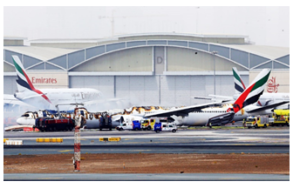It’s No Miracle Everyone Escaped That Fiery Dubai Plane Crash
Once the smoke had cleared from the runway at Dubai International Airport, you could see the wreckage of what you’d assume was an unsurvivable crash. The fuselage of the Boeing 777 was burnt and twisted. The entire top of the plane’s body melted away, down to the level of the windows, and what was visible of the interior was charred beyond recognition. How could anyone have escaped? Yet every one of the 300 people on board got out safely after the jet landed hard and caught fire Tuesday morning. (One firefighter died in the blaze.)
Investigators are now working to discover what brought down Emirates flight EK521, which flew to Dubai from Thiruvananthapuram, India—photos indicate the landing gear didn’t deploy. What is already clear is that everything went right with the evacuation.
Unsurprisingly, passengers spoke of a terrifying, unexpected trauma. The 18 crew members may have been surprised, but they—like the plane they command—were ready for the worst.
“Crashworthiness is an aeronautical engineering concept as important as airworthiness, and the 777 has had a sterling record for survivable crashes,” says Stephen Trimble of Flight Global, an aviation industry news source. It’s built into the voluminous FAA regulations any aircraft must meet before entering service: Along with using flame-resistant materials wherever possible, the likes of Boeing and Airbus must prove their aircraft can be fully evacuated within 90 seconds—using just half the exits.
To test that, real people are put into numbered bibs and belted into seats on a parked plane. When given the signal, they must navigate blocked exit routes, debris scattered through the cabin, and semi-darkness before leaping onto an inflatable slide.
That test doesn’t perfectly imitate reality: The “passengers” are alert and expecting the order to scram, not sleepy and wondering where they put their passport. They won’t shove past each other to survive, or grab their carry-on on the way out. (In one case, Airbus recruited gym members and had them warm up before the test.) The slides are pre-deployed for their safety, and airline employees lay down mats around them so no one cracks their head.
Still, it’s an impressive demonstration of modern plane design. When Airbus certified its A380 in 2006, 873 people got off the plane in just 78 seconds. Even if it takes two or three times longer in a crash, it’s remarkable.
To make that happen, you need more than well-marked exits: the cabin staff are crucial for an effective evacuation. Emirates says in this case, its crew executed their procedures professionally, and only left the plane once their 282 passengers were safe. Along with first aid and dealing with obnoxious passengers, those safety procedures are a key part of their intense, five-week training.
“They did a wonderful job,” says Hans Hans Weber, president of Tecop International Inc, an aviation consultancy. “The speed with which they evacuated, they must have had passengers on board who followed orders.”
And that’s the final critical element: the passengers. Crashes like this one are a good reminder that while it’s tempting to ignore the safety announcements that kick off every flight, you should how to get off your plane. Count the rows from your seat to the nearest exit, so you can find it in the dark or if smoke fills the cabin. If you’re in an emergency exit row, know how to operate the door. Do not stop to collect your luggage like some passengers fleeing Asiana Flight 214 after crashing in San Francisco in 2013.
And then relax and enjoy your flight, knowing that if the worst does happen, you, your crew, and your plane are ready.
https://www.wired.com/2016/08/dubai-plane-crash-emirates-flight-ek521/





